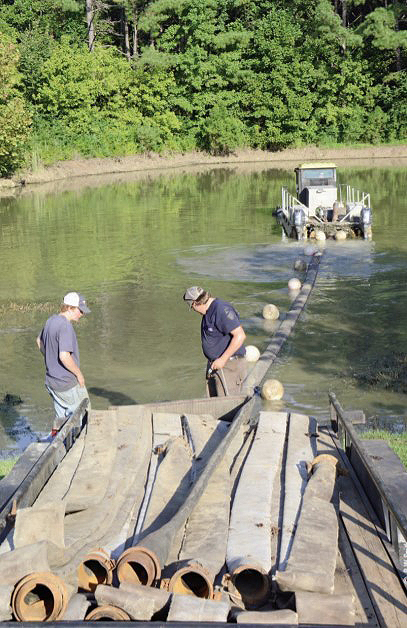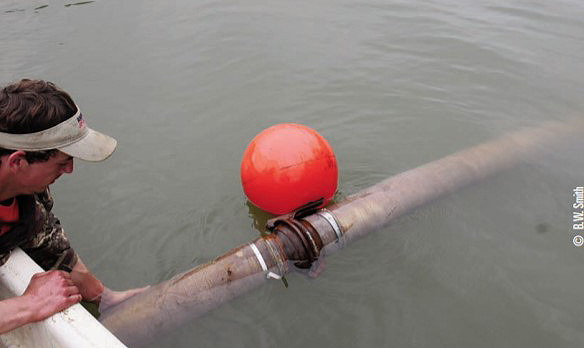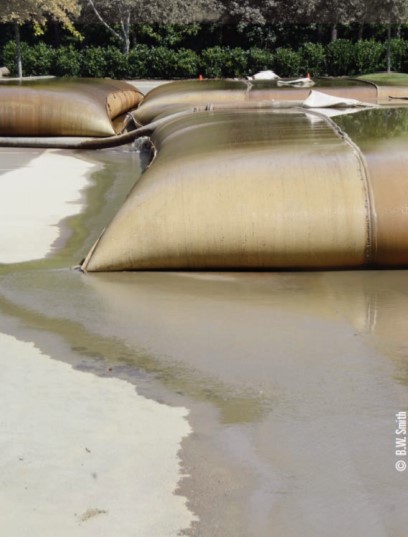Barry W. Smith | Originally published in GameKeepers: Farming for Wildlife Magazine. To subscribe, click here.

Many of us have seen small ponds or upper ends or sloughs of larger lakes gradually fill in with silt to form extremely shallow areas or even islands. These areas often begin to vegetate and become unsightly. Not only are these silted areas esthetically unpleasing but there is a loss of fish spawning areas and valuable fish habitat. This material can be easily removed by new hydraulic dredging techniques that deposit sediment in Geo-bags up to a thousand feet from the dredge site. Water leaches out of the synthetic fabric of the bags allowing the solid material to dry and be easily disposed of at a later time.

of the dredging barge can carry silt and detritus for more
than 1,000 feet to a discharge site.
In years past, there were basically three techniques to evacuate material from lakes and ponds. The first was to physically remove the wet material utilizing draglines or large track hoes and haul this wet material away from the site in large dump trucks. Not only was this method inefficient, but it made a big mess and required areas around the lake shore that could be accessed by heavy equipment. Can you imagine trying this in a developed subdivision?
The second technique involved a large dredge that often had to be lifted into the lake with a crane. The material was then pumped offsite to dry and be hauled away using heavy equipment. This type of equipment may be suitable for large lakes that are accessible by heavy equipment and where the shoreline area can be allowed to “heal” over time.
The third technique was to drain the lake and let it dry so that heavy equipment such as bulldozers and earth-moving pans could reshape the pond bottom and use the excess material to make an island or peninsula within the lake. Or haul the excess material to another site.
In a lot of today’s situations none of the above options would be a satisfactory choice in restoring a pond or lake to its original condition. There is a new option that can work in almost any situation and does not leave much of an environmental footprint. New materials resulting from modern technology have made dredging almost any lake possible.
John Crabb, president and founder of Estate Management Services, specializes in the management of all size lakes from subdivision developments to municipal storm-water ponds in more than seven states, says the advent of the Geo-bag has been a game changer for hydraulic dredging. “We can launch a medium-size hydraulic dredge with an 8-foot cutter head and pump the silt, sand and detritus into a Geo-bag located in a field, on the pond dam or even in a paved parking lot,” says Crabb. “We can then let the solid material that we pump from the lake, dry in the bag and remove the bag with a special roll back truck and container.”

Sawyer Chiles, Co-owner of American Sport Fish Hatchery, owns and operates one of these barges. “We can launch our barge in almost any pond or lake that is deep enough to float it,” says Chiles. “We can move our barge and equipment across manicured lawns using new hydromats and not leave a track. It is a huge advantage for us working around high-end developments and lakes that are not accessible by heavy equipment. The use of Geo-bags in conjunction with our highly maneuverable dredge is the key to our success with hydraulic dredging in lakes that could otherwise not be cleaned up.” Chiles says their dredge is large enough to handle large scale jobs but small enough that it can be maneuvered inside most boat slips.

In more rural settings, the sediment can be pumped onto fields and allowed to dry as the water can run back into the lake. In most situations however, Geo-bags are used.

a field, on the pond dam, or even in a paved parking lot.
The 8-foot cutter head on American Sport Fish’s barge is controlled hydraulically and can be moved up or down by the barge operator. Once the silt has been disturbed, it is sucked through a vacuum pump and sent through a 6-inch hose directly to the Geo-bag or discharge area. The hose or pipe is attached to the back of the barge and suspended near the surface of the lake by large floats. A small skiff can move the hose or pipe as the barge changes dredging location. “We can pump the silt, sand and detritus more than 1,800 feet to be deposited off-site,” says Chiles.
“More than half Estate Management Service’s dredging projects involve municipal storm drainage ponds or sediment ponds that are required by permit to be dredged on a periodic basis,” Says Crabb. “However we also dredge home owner association (HOA) lakes and private lakes to improve fish habitat, drainage and esthetics. Our experience with large equipment is there is too much collateral damage to make its use worthwhile.” Crabb attributes many of the HOA lakes with the building boom of 10 years past, where lakes were constructed to increase home values. “Most of these lakes were constructed for esthetics and were only two to three feet deep. This shallow depth allowed them to fill in rapidly,” says Crabb. Run off from bare soils, such as building sites or new road construction, can rapidly fill the upper ends of any lake or pond. If your lake has lost some of its habitat, hydraulic dredging could be the answer to your problem.































